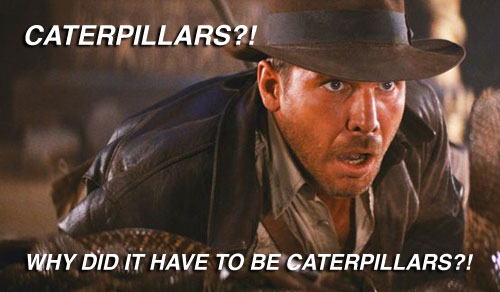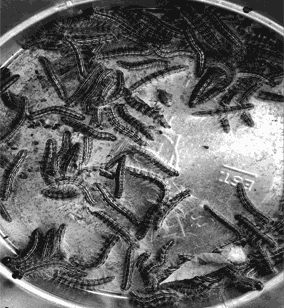
Alert Gazette readers will recall my lament from last spring regarding an infestation of walnut caterpillars and their fecal flotsam. Well…lucky us. It turns out that these creatures make twice annual appearances — spring AND fall — and we’re now in the middle of their curtain call.
This is also the time of year that the pecan trees begin to drop their leaves, so we’re dealing not only with caterpillar poop falling onto our deck from the trees in our back yard, but also the leaves. My mid-morning ritual now consists of firing up the leaf blower in an attempt to bring a modicum of order to the deck and back porch. Of course, those efforts yield results that last at best a half hour or so, but, like Sisyphus pushing that rock, my fate is simply to keep trying.
Now, all of this is annoying enough, but this is also the time of year when the walnut caterpillars launch themselves from the tree and rain down like multi-legged storm troopers. In the past, we’ve tried (a) ignoring them, (b) sweeping them, and (c) squishing them. The first approach proved unworkable, the second was futile, and the third was gross. So, this time around I’ve initiated Option D: harvesting them.
Equipped with leather gloves and a bucket, I’ve picked up literally hundreds of caterpillars. I realize that for every one I catch, there are probably a hundred more that go…somewhere. But I figure that for every one I catch, that’s one less to deal with next spring when the next generation hatches.
I haven’t figured out their life cycle or behavioral patterns. I mean, they drop out of the trees, but then immediately find the nearest wall and start climbing back up again. I don’t know; maybe it’s like an amusement park ride to them. But it’s a somewhat unsettling thing to stand on the back porch to watch — and hear…they make a faint but obvious plop when they hit — them fall. They seem to be slightly stunned when they hit the deck, but quickly recover and start crawling around.
Anyway, I’m collecting caterpillars by the bucket, and the creepiness factor increases when you look into said bucket. The following scene brings to mind the phobia of Indiana Jones:

They could be really short snakes.
As with most things, this too shall pass. At least walnut caterpillars don’t transmit COVID-19.
Do they?
Discover more from The Fire Ant Gazette
Subscribe to get the latest posts sent to your email.

Life Cycle: Adults emerge from pupae which overwinter in the soil at the base of a host tree. The female moth deposits about 300 eggs on the underside of a leaf. Caterpillars (larvae) hatch from the eggs in about 9 days, living together in a group. The caterpillars often move in a group to the tree trunk to molt from one stage (instar) to the next, leaving a patch of fur-like hair and cast skins. When they finish feeding, they drop to the ground and pupate in the soil. They do not spin a cocoon but form a naked pupal case. Populations of this species are variable from year to year and there may be several years between outbreak levels. In Texas, at least two generations of the insect develop each year. The second generation is usually larger in number and causes more damage.
Habitat, Food Source(s), Damage: Caterpillars have chewing mouthparts. Adults have siphoning mouths. Host plants include hickory, walnut, oak, willow, honey locust and certain woody shrubs. Young larvae feed only on soft tissue, leaving a skeletonized leaf behind, while older larvae feed on the entire leaf, including the petiole. The last few stages, or instars, do the majority of the feeding damage. Damage may be localized to just a branch to two because they feed together. Isolated trees are more subject to attack than forest or orchard trees. They can rapidly defoliate ornamental and orchard trees if not controlled. In some past years, almost all of the native pecan trees in certain areas of the state were defoliated by walnut caterpillars.
Unicorn caterpillar, Schizura unicornis (J. E. Smith) (Notodontidae), on swamp rose. Photo by Drees.
Unicorn caterpillar, Schizura unicornis (J. E. Smith) (Notodontidae), on swamp rose. Photo by Drees.
Pest Status: A serious but occasional threat to pecan, hickory, walnut and other trees and shrubs. It also feeds on oak, willow, honey locust and certain woody shrubs.
For additional information, contact your local Texas A&M AgriLife Extension Service agent or search for other state Extension offices.
Ken, I actually looked at this website plus several others. I’m still confused about why our guys are dropping to the ground and then crawling back up the walls of our house.
I think ours are just dumber than the average caterpillar.